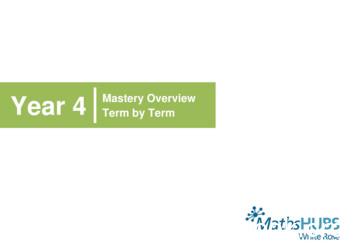Calculus III Week 6
Calculus III – Week 6September 27 – October 1, 2021Hey everyone! My name is Savanah Smith, and I am the Master Tutor for Calculus III thissemester. I hope these resources can become a great studying and review tool for everyone whoencounters them. I will also be having weekly Group Tutoring sessions where we will go overthe topics and practice problems covered in these resources, so feel free to check that out asdescribed below! Please don’t hesitate to reach out to me with any questions or comments orwhen in doubt go to the tutoring website! I hope your first round of exams goes well!Group Tutoring: Mondays from 5:15 – 6:15 pmIn Sid Rich Basement, Room 75Reserve a spot at baylor.edu/tutoringThis week classes should be covering the remainder of Chapter 14 which includes sections14.5-14.7.Key Words: Gradient, Directional Derivatives, OptimizationTOPIC OF THE WEEKGradientsThe gradient 𝑓𝑃 of a function 𝑓 is the vector containing thepartial derivatives of 𝑓 in each direction at point P (a, b, c). 𝑓𝑃 𝑓(𝑎, 𝑏, 𝑐) 〈𝑓𝑥 (𝑎, 𝑏, 𝑐) , 𝑓𝑦 (𝑎, 𝑏, 𝑐) , 𝑓𝑧 (𝑎, 𝑏, 𝑐) 〉Or it can be written without the point P: 𝑓 〈 𝑓 𝑓 𝑓〉, , 𝑥 𝑦 𝑧Important Properties:Gradient for 𝑓 𝑥 2 𝑦 2Addition: (𝑓 𝑔) 𝑓 𝑔Scalar multiple: (𝑐𝑓) 𝑐 𝑓, c is a constantProduct Rule: (𝑓𝑔) 𝑓 𝑔 𝑔 𝑓All pictures, tables, and information if property of Calculus Early Transcendentals (4 th Edition)by Rogawski, Adams, and Franzosa.
Chain Rule: (𝐹(𝑓(𝑥, 𝑦, 𝑧))) 𝐹′(𝑓(𝑥, 𝑦, 𝑧)) f F is a differentiable functionSame method where you take the derivative of the outside and then the inside.Ex. Find the gradient of 𝑔(𝑥, 𝑦, 𝑧) (𝑥 2 𝑦 2 𝑧 2 )8OutsideInside𝐹 𝑓(𝑥, 𝑦, 𝑧)8𝑎𝑛𝑑𝑓(𝑥, 𝑦, 𝑧) (𝑥 2 𝑦 2 𝑧 2 )𝐹 ′ 8 𝑓(𝑥, 𝑦, 𝑧)7 𝑓 〈 𝑓𝑥 , 𝑓𝑦 , 𝑓𝑧 〉𝐹 ′ 8(𝑥 2 𝑦 2 𝑧 2 )7 𝑓 〈 2𝑥, 2𝑦, 2𝑧 〉 𝑔 𝐹 ′ 𝑓 𝑔 8(𝑥 2 𝑦 2 𝑧 2 ) 7 〈2𝑥, 2𝑦, 2𝑧〉Another important note: the gradient of a function is perpendicular to itslevel curves and points in the direction of maximum increase of the function.(see picture on the right)HIGHLIGHT #1: CHAIN RULE FOR PATHSA path is a curve in 3 dimensions represented by a vector-valued function 𝒓(𝑡). Recall that if𝒓(𝑡) represents position, 𝒓′ (𝑡) represents velocity or a rate of change.Chain Rule for Paths: dot product between the gradient of f and the derivative of 𝒓(𝑡)𝑑𝑓 (𝒓(𝑡)) 𝑓𝑟(𝑡) 𝒓′(𝑡)𝑑𝑡𝑑 𝑓 𝑓 𝑓 𝑓 ′ 𝑓 ′ 𝑓 ′𝑓(𝒓(𝑡)) 〈 , , 〉 〈 𝑥 ′ (𝑡), 𝑦 ′ (𝑡), 𝑧 ′ (𝑡)〉 𝑥 (𝑡) 𝑦 (𝑡) 𝑧 (𝑡)𝑑𝑡 𝑥 𝑦 𝑧 𝑥 𝑦 𝑧This is used to describe how a variable f changes along thepath r(t). An example is determining how the temperaturechanges as one travels along a path throughout the U.S (seepicture)All pictures, tables, and information if property of Calculus Early Transcendentals (4 th Edition)by Rogawski, Adams, and Franzosa.
The chain rule can also be used in the same way for composite functions of two variables wherex, y, and z are differentiable by the independent variables s and t.𝑓(𝑥(𝑠, 𝑡), 𝑦(𝑠, 𝑡), 𝑧(𝑠, 𝑡))We can either take the derivative of 𝑓 in terms of s or t. 𝑓 𝑓 𝑥 𝑓 𝑦 𝑓 𝑧 𝑠 𝑥 𝑠 𝑦 𝑠 𝑧 𝑠 𝑓 𝑓 𝑥 𝑓 𝑦 𝑓 𝑧 𝑡 𝑥 𝑡 𝑦 𝑡 𝑧 𝑡HIGHLIGHT #2: DIRECTIONAL DERIVATIVESOne application of using the chain rule for paths is directional derivatives.Consider a line through a point 𝑃 (𝑎, 𝑏) in the direction of a unit vector𝒖 〈ℎ, 𝑘〉. The parametric equations would then be:𝒓(𝑡) 〈𝑎 ℎ𝑡, 𝑏 𝑘𝑡〉Directional Derivative: the derivative of 𝑓(𝒓(𝑡)) at 𝑡 0 with respect to uat P. Notation: 𝐷𝑢 𝑓(𝑃) or 𝐷𝑢 𝑓(𝑎, 𝑏) This represents the rate of change of 𝑓 along the path represented bythe point P and the unit vector u.𝐷𝑢 𝑓(𝑃) 𝑓𝑃 𝒓′ (0) 𝑓𝑃 𝒖The directional derivative needs to include a unit vector, u. One mustdivide a vector by its magnitude to result in a unit vector.𝒗𝒖 ‖𝒗‖𝒓′ (𝑡) 〈ℎ, 𝑘〉 𝒖Since there is no t value,𝒓′ (0) 𝒖The angle between 𝑓𝑃 and 𝒖 can be solved for using the equationbelow. Also known as the angle between the gradient and the direction.𝐷𝑢 𝑓(𝑃) 𝑓𝑃 𝒖 ‖ 𝑓𝑃 ‖𝑐𝑜𝑠𝜃Similarly, the angle of inclination, 𝜓 can be found. For example, theangle of inclination can be described as the angle between the groundand the side of a mountain.𝐷𝑢 𝑓(𝑃) tan(𝜓)All pictures, tables, and information if property of Calculus Early Transcendentals (4 th Edition)by Rogawski, Adams, and Franzosa.
HIGHLIGHT #3: OPTIMIZATIONOptimization: process of finding the extreme values of a function, the local and globalmaximum and minimums Local: within a specified region or disk, D Global: within the entire domain of a function (aka absolute)Step 1: Find critical points Critical points: points where the tangent plane is horizontal Point 𝑃 (𝑎, 𝑏) is a critical point if:𝑓𝑥 (𝑎, 𝑏) 0 𝑎𝑛𝑑 𝑓𝑦 (𝑎, 𝑏) 0 𝑜𝑟 𝑑𝑜 𝑛𝑜𝑡 𝑒𝑥𝑖𝑠𝑡Step 2: Second Derivative Test D is also called the discriminate Determines the type of critical point using the equation:2𝐷 𝑓𝑥𝑥 (𝑎, 𝑏)𝑓𝑦𝑦 (𝑎, 𝑏) 𝑓𝑥𝑦(𝑎, 𝑏)All extreme values will be local. In order to find global extrema, theinterior and boundaries of the domain must be evaluated for criticalpoints. The highest and lowest critical points will be the globalextrema.The following videos are great resources to use for additional explanationof the topics covered in this resource!Video Series on Gradients and Directional ntand-directional-derivativesChain Rule for -chain-rule/v/multivariable-chain-ruleOptimization (including global):https://www.youtube.com/watch?v Hg38kfK5w4EAll pictures, tables, and information if property of Calculus Early Transcendentals (4 th Edition)by Rogawski, Adams, and Franzosa.
CHECK YOUR LEARNING1. Calculate 𝑓(3, 2,4) where 𝑓 𝑧𝑒 2𝑥 3𝑦 .2. Find the directional derivative in the direction of 𝑣 〈2,3〉. Let 𝑓 𝑥𝑒 𝑦 and 𝑃 (2, 1).3. Calculate 𝑓where 𝑓 𝑥𝑦 𝑧 and 𝑥 𝑠 2 , 𝑦 𝑠𝑡, 𝑧 𝑡 2 . 𝑠4. Find the local extrema of 𝑓(𝑥 2 𝑦 2 )𝑒 𝑥 .THINGS YOU MAY STRUGGLE WITH1. A lot of things in Calculus III can be difficult to visualize since everything is shifted into3 dimensions. Rely heavily on pictures, videos, or online 3D graphs to help be able tovisualize what you are doing.2. Most of these calculations have multiple steps are dealing with 3 variables. Be sure totake your time and ensure you know the purpose of each variable and what to do with it.It’s okay to make a chart or write out a bunch of intermediate steps to help you stayorganized.That’s all for this week! I hope this was a helpful review of Chapter 14.5 - 14.7!Feel free to visit the Tutoring Center Website for more information atwww.baylor.edu/tutoring.Answers:1. 𝑓(3, 2,4) 〈8,12,1〉2. 𝐷𝑢 𝑓(𝑃) 0.82 𝑓3. 𝑠 2𝑠𝑦 𝑥𝑡4. (0,0) is a local min, (2,0) is saddleAll pictures, tables, and information if property of Calculus Early Transcendentals (4 th Edition)by Rogawski, Adams, and Franzosa.
All pictures, tables, and information if property of Calculus Early Transcendentals (4th Edition) by Rogawski, Adams, and Franzosa. The chain rule can also be used in the same way for composite functions of two variables where x, y, and z are differentiable by the independent variables s and t.
(prorated 13/week) week 1 & 2 156 week 3 130 week 4 117 week 5 104 week 6 91 week 7 78 week 8 65 week 9 52 week 10 39 week 11 26 week 12 13 17-WEEK SERIES* JOIN IN MEMBER PAYS (prorated 10.94/week) week 1 & 2 186.00 week 3 164.10 week 4 153.16 week 5 142.22 week 6 131.28 week 7 120.34
Week 3: Spotlight 21 Week 4 : Worksheet 22 Week 4: Spotlight 23 Week 5 : Worksheet 24 Week 5: Spotlight 25 Week 6 : Worksheet 26 Week 6: Spotlight 27 Week 7 : Worksheet 28 Week 7: Spotlight 29 Week 8 : Worksheet 30 Week 8: Spotlight 31 Week 9 : Worksheet 32 Week 9: Spotlight 33 Week 10 : Worksheet 34 Week 10: Spotlight 35 Week 11 : Worksheet 36 .
5500 AP Calculus AB 9780133311617 Advanced Placement Calculus: Graphical Numerical Algebraic 5511 AP Calculus BC n/a Independent 5495 Calculus 9781133112297 Essential Calculus 5495 Calculus - optional - ebook 9780357700013 Essential Calculus Optional ebook . 9780134296012 Campbell Biology 9th Ed
webwork answers calculus, webwork answers calculus 2, webwork answers calculus 3, webwork solutions calculus 3, webwork answer key calculus In Algebra and Geometry, the WebWork assignment must be finished by 10pm . Students in our Calculus 1-3
28 Solving and Graphing Inequalities 29 Function and Arrow Notation 8th Week 9th Week DECEMBER REVIEW TEST WEEK 7,8 and 9 10th Week OCTOBER 2nd Week 3rd Week REVIEW TEST WEEK 1,2 and 3 4th Week 5th Week NOVEMBER 6th Week REVIEW TEST WEEK 4,5 and 6 7th Week IMP 10TH GRADE MATH SCOPE AND SEQUENCE 1st Week
Year 4 negative numbers. digit numbers by one digit, integer Year Group Y4 Term Autumn Week 1 Week 2 Week 3 Week 4 Week 5 Week 6 Week 7 Week 8 Week 9 Week 10 Week 11 Week 12 Number – place value Count in multiples of 6, 7, 9. 25 and 1000. digits using the formal writt
WRM –Year 6 –Scheme of Learning 2.0s Week 1 Week 2 Week 3 Week 4 Week 5 Week 6 Week 7 Week 8 Week 9 Week 10 Week 11 Week 12 tumn Number: Place Value N
Christian Parkinson GRE Prep: Calculus II Notes 1 Week 2: Calculus II Notes We concluded the Calculus I notes with Riemann integration, Fundamental Theorem of Calculus and some helpful integration techniques. However, ofter times, you will be asked to identify whether an integral conv






















